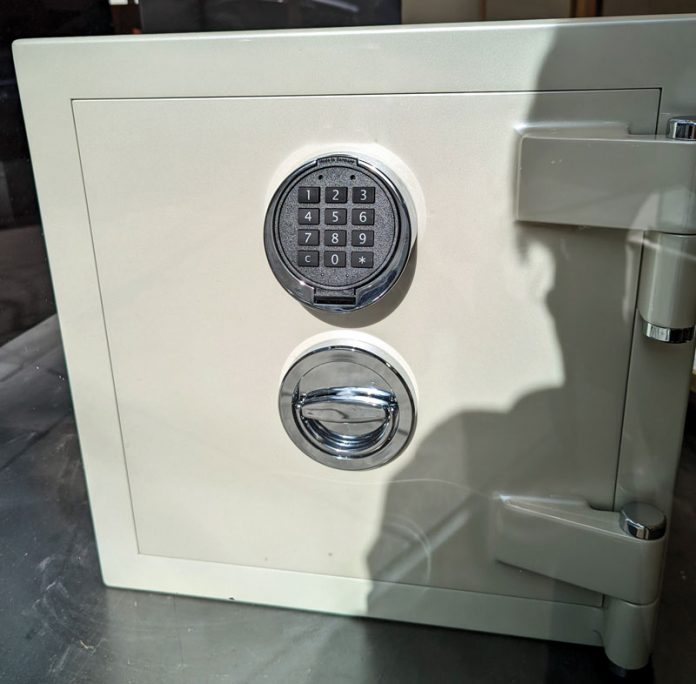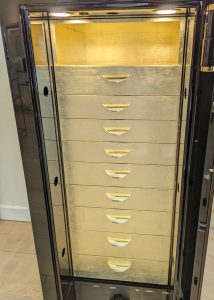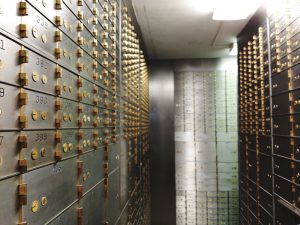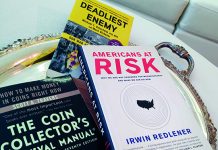
What is the safest way to store coins? Some say home safes are best for safe coin storage. Others argue safety deposit boxes are best. Here’s the lowdown.
The Argument for Home Safes
Home safes are becoming more and more popular with coin collectors. People are spending the money to buy their first safe or upgrade their existing safe to keep their coins secured in their homes. Why? The pandemic raised concerns about a lack of access to important belongings in an emergency. Some large banks closed vaults for months at a time, and customers were unable to retrieve their documents and valuables. Not only was this inconvenient, but people were also unable to sell their gold if they chose to. Here are some rules for safe coin storage and access.
Don’t store anything in a safe deposit box that you might need in an emergency or on short notice.
Your passport, power of attorney, COVID vaccine card and original last will and testament, for example, don’t belong in a safe deposit box. Even with banks operating normally, in the event you need one of these documents over a weekend, you might not be able to get it. But with bank closures now commonplace, lack of access for extended periods can be problematic.
Be guided by your insurance carrier, attorney and your personal needs for storing valuables in a safe deposit box or home safe.
Safe deposit boxes are generally not insured by the bank. Storage of your coins and metals should be insured, and you should consult with your carrier on policy limitations. Some attorneys recommend that certain safe deposit boxes be in the name of a Limited Liability Company (LLC).

Don’t buy a safe for your home until you consult with your insurance carrier and architect.
Safes carry ratings for burglary and fire protection, and most decisions relating to purchases of safes are made according to insurance carrier requirements for coverage.
Make sure your floor can bear the weight of a safe before you buy and install it.
Home safes can weigh hundreds of pounds; commercial safes can weigh thousands of pounds. Placing your safe in the basement is no substitute for consulting an architect; basements are prone to flooding. Sometimes placing your safe on a higher floor will prevent water intrusion.
Buy safes that are rated by UL (Underwriters Laboratories) in the U.S. or VdS (Verband der Schadenversicherer) in Europe.
Safes available that are tested by UL for protection against burglary have ratings from TL-15 through TXTL-60. A TL-15 safe resists entry for 15 minutes; a TXTL-60 is tested to withstand 60 minutes of entry attempts and is explosion resistant. Safes also carry fire ratings. Class A offers four-hour protection from a temperature of 2000 °F; Class B is supposed to provide two hours of protection from a temperature of 1850 °F, and Class C offers one-hour protection when the temperature is 1700 °F.
Antoine Trove, luxury retail managing director at Traum Safe, a leading provider of bespoke safes in New York, says that high-end safes are selling briskly in this environment. His firm is selling safes priced at over $100,000 each at a rate of about one every week.
Trove points out that Traum safes are covered by VdS ratings. VdS safe tests are among the most comprehensive in the world. VdS adjusts its testing methods to changing technologies, skill sets and toolsets used to compromise safes. VdS considers the advanced testing methods to be proprietary and doesn’t reveal details of the advanced methodologies used.
VdS ratings appear in Resistance Unit (RU) shorthand: A single RU, for example, means that the safe has been tested to withstand one minute of intrusion attempts using a basic toolset. To keep the ratings in a universal language, recognizable and defined standards, such as Europe’s EN 1143-1 burglar resistance test, are used.
Similar to UL standards in the U.S., EN 1143-1 takes into account how long it takes to compromise a safe and what tools are needed.
Making the Case for Safety Deposit Boxes
Storing valuable coins in a nearby and easily accessible bank safe deposit box is a practice I have long supported. Retired FBI agents and police chiefs with whom I’ve discussed this share the belief that you are safer storing your coins in a bank than at home.
 You may prefer to have personal and handy access to your coins at home. But if criminals gain access to an unprotected occupied home, they could compel a homeowner to divulge the contents of a safe using threats or intimidation. There is also a risk of fire or flooding at home.
You may prefer to have personal and handy access to your coins at home. But if criminals gain access to an unprotected occupied home, they could compel a homeowner to divulge the contents of a safe using threats or intimidation. There is also a risk of fire or flooding at home.
The potential for flood damage is one reason why I recommend that you select a safe deposit box well off the ground floor level of the bank, preferably at least four or five feet if you live in an area like mine where there is potential flooding.
Neither do I recommend burying or storing coins in remote areas, as variables can change to preclude you from retrieving the coins.
The solution to the dilemma of some banks no longer renting new safe deposit boxes is that you should monitor conditions, carefully review bank correspondence received, and do nothing if you already have a safe deposit box in a bank you trust that has always given you access when you need it.
If you do not have a safe deposit box in such a bank, you need to locate a favored bank that will open a safe deposit box for you and, if not, shop for a bank that will allow new safe deposit box accounts.
This story about what is the safest way to store coins previously appeared in COINage magazine. Click here to subscribe. The case for home safes by Scott A. Travers. The case for safety deposit boxes by Mike Fuljenz.














